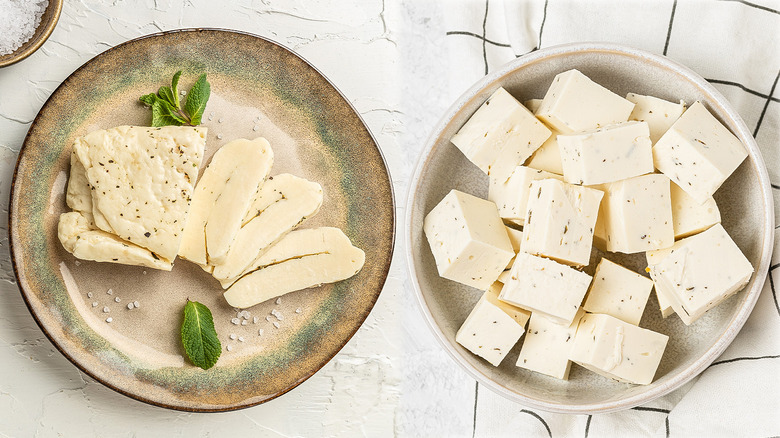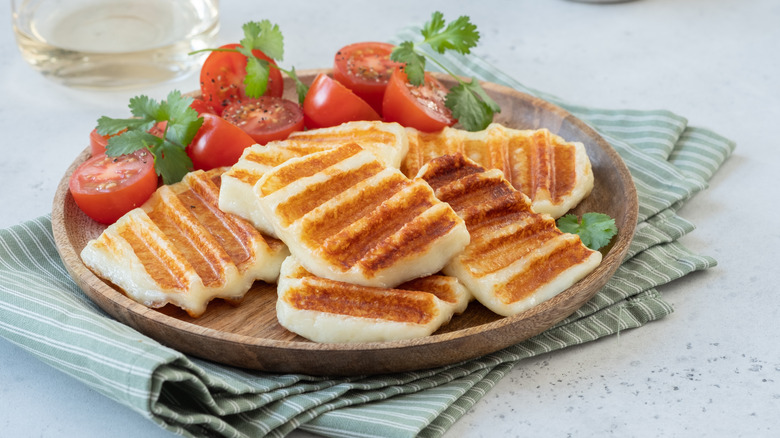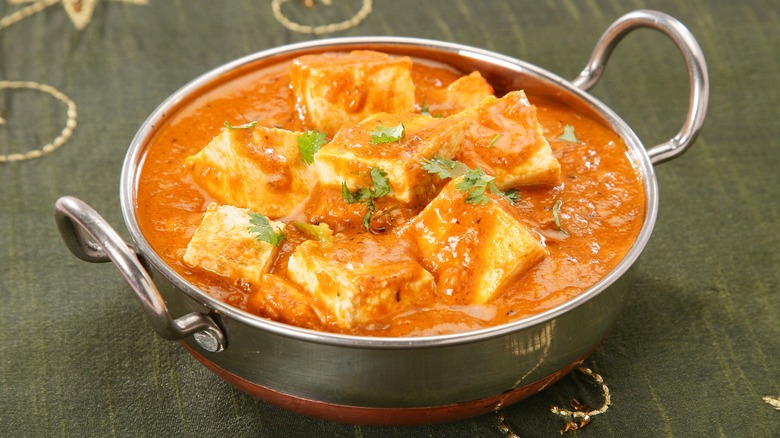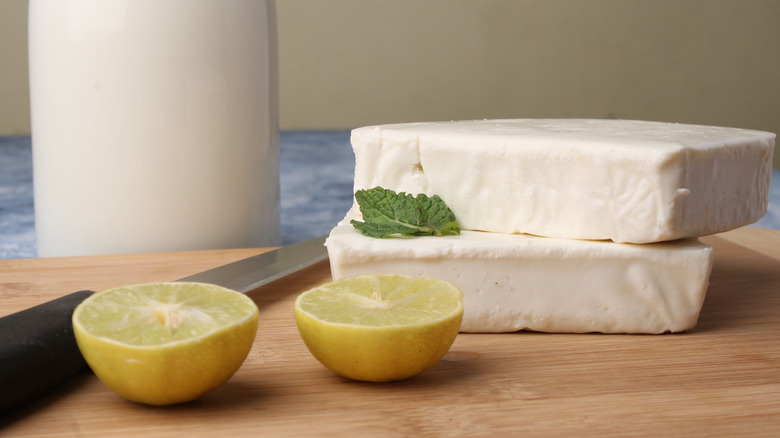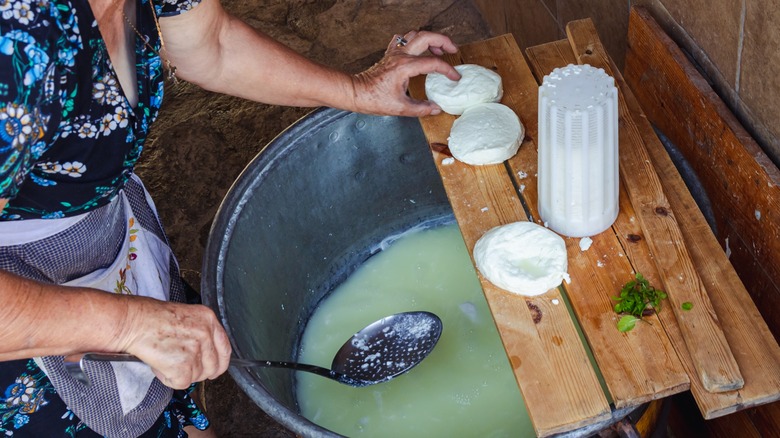Halloumi Vs Paneer Cheese: What's The Difference?
Some cheeses are the perfect addition to an appetizer spread, like creamy Brie. Others are ideal for crumbling or shredding on a salad, like feta or cheddar. And still, other cheeses have the perfect melty texture for pizza and panini, like provolone or mozzarella. But there are two, firm white cheeses with savory flavors that stand out for their ability to not melt, but instead add a sturdy protein-packed bite to a meal — halloumi and paneer.
They look very similar — white rectangles of dense milky cheese, but the flavors are quite different. Halloumi is salty and retains a pleasant flavor that reflects the type of milk used by the cheesemaker, possibly sheep, goat, cow, or a blend of the three. Paneer is very mild, almost flavorless, with less salt, sometimes reminiscent of tofu. The two cheeses stand up to the heat of cooking, giving them the ability to get crispy, brown edges and not dissolve away into a simmering skillet of sauce.
What is halloumi cheese?
Halloumi is an ancient style of semi-hard cheese, documented as far back as the 8th century BCE. It's the national cheese of Cyprus, the rugged Mediterranean island known as the crossroads between Europe and Asia for hundreds of years. The terrain of Cyprus is ideal for raising sheep and goats, which is the traditional milk source for creating these simple blocks of cheese. The pressed curds are simmered in salted whey, a step that pulls out moisture from the cheese. and adds salt resulting in a long-lasting product that can survive in a hot climate. The finished chunks of halloumi get a final sprinkle of salt and are stored in brine until they're sold and enjoyed.
The dry nature of halloumi makes it perfect for heating, either in a pan or on the grill. As halloumi is fried, the exterior gets brown and crispy while the interior becomes melty and smooth. Cooked slabs of halloumi are delicious in sandwiches, or as a part of a warm salad, but don't neglect to try uncooked halloumi right from the package. The salty fresh flavor is enjoyed with watermelon in Cyprus and would be perfect with any other flavorful melon where the salt-sweet contrast accentuates the fruit's flavor.
What is paneer cheese?
Paneer is one of the easiest cheeses to make at home — it just requires milk and a form of acid, like lemon or vinegar, some heat, and a pot. In fact, the lack of animal rennet to set the curds makes paneer one of the most reliable vegetarian cheese choices. The firm, mild cheese has been a staple in Indian kitchens since the 16th century, when it was introduced through the influence of Persian rulers. Water buffalo milk was the dairy source of choice for paneer because the high fat content makes a rich flavor and creamy texture, but today, full-fat cow's milk is typically used. After heating the milk, a small amount of acid, such as lime juice, buttermilk, or vinegar, is added which clumps the milk proteins together, forming whey and curds. The curds can be eaten as is, like a tofu scramble, or pressed to make a firm slicing cheese.
Paneer has a high melting point, so it stays in firm slabs or cubes which can be the center protein of a meal like pureed, spiced spinach-rich palak paneer. The cheese is relatively flavorless, making it a great base for spices and marinades, too. Cubes of paneer can be pan-seared to get a brown and crunchy crust, and they make perfect skewers for grilling.
The milk source is one big difference between the cheeses
While halloumi and paneer might look similar, there are some flavor differences to be aware of that come mostly from the milk source. Halloumi doesn't have a strong flavor like goat cheese or piquant sheep's milk pecorino, but there is an essence of those milks lingering in the finished cheese. In 2021, Cyprus received naming protection within the EU, so technically any cheese labeled as halloumi originates there. The local governing board regulates the production, so at least 51% of the milk needs to be from sheep. Similar cheese made in the U.S. might be called halloumi-style, or grilling cheese, and the milk source might vary.
The cow's milk used to make paneer is a familiar flavor for most of us — think of cottage cheese, and you'll know the taste of paneer. Water buffalo paneer is a more unusual source, but that milk is very mildly flavored as well. Paneer is a flavor chameleon thanks to its mild milk source, making it perfect for South Asian recipes.
The production method also differentiates these cheeses
Because halloumi and paneer are firm and can both withstand high temperatures, you might assume they have some similarity in production techniques, but you'd be wrong! Halloumi starts as most cheeses do, by warming the milk to a temperature that helps activate natural enzymes. Then rennet is added to form firm, cuttable curds. Rennet, a natural enzyme in the stomachs of young animals, is a common ingredient in cheese. Once the curds form, they're drained, pressed, and cooked in their own whey, and no acid is added. It's this heat processing and very low acid content that makes halloumi's unique texture.
By contrast, paneer is a high-acid cheese due to the ingredients used to curdle the milk and form the curds. It turns out that both high and low acidity in cheese results in the firm, non-melting texture we love in these two cheeses. Using lemon juice or another mild acid to set the curds gives paneer a smaller curd structure, so even when it's pressed there's plenty of space in the pressed cubes to absorb marinade.
